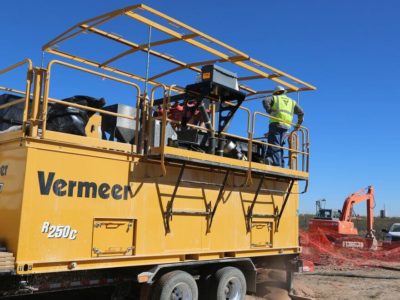When installing large-diameter product, you need lots of fluid. But what if you’re not near a water source?
That’s where a Vermeer reclaimer comes in.
Vermeer reclaimers, like the Vermeer R250C reclaimer, are mud recycling systems that maximize your big-bore operation’s efficiency. They use solids control equipment to remove solids and send fluids back down your horizontal directional drill string, minimizing trips away from the jobsite for more fluids or to dispose of excess waste.
How does the R250C work?
Vermeer reclaimers have three lines of defense: scalping screens, desilter cones, or hydrocyclones, and the shaker decks.
“The goal is to remove the detrimental solids,” said John Cope, Vermeer applications engineer. “The slurry itself is made up of water, bentonite and other beneficial drilling additives.”
The pit pump takes the drilling fluid full of cuttings to the scalping screens first. While there, it goes through mesh shaker screens to sort out the larger particles from the usable drilling fluid.
The dewatering of solids during the first stage is assisted by the elliptical motion of the scalping screen of the R250C.
“The elliptical motion rolls the solids instead of beating the fluid out of them,” said Cope. “This motion also creates less ultra-fines than the alternative motion because it doesn’t beat the solids into smaller particles.”
The slurry then moves to the next stage of the separation process, the desilter cones. These hydrocyclones remove finer sands and coarse silts.
The third stage of defense is the shaker decks, another layer of shaker screens just below the hydrocyclones. By the end of this process, the dry cake of solids will be separated to be disposed of while the fluid can go right back down the drill string.
Caring for your reclaimer screens
The screens are an integral part of the reclaimer’s function. Not only is it important to use the right style of screens for the job, but they must also be maintained.
Because screens are such high use items, having extra on hand is a good idea. Not sure how many to have? It’s a good idea to have a wide variety of mesh to be prepared for differing soil conditions. Your local Vermeer dealer is a great resource for helping to determine how many of each kind to have.
One way to minimize the number of times you change the screens is through preventative maintenance.
Here are some tips for how to maintain your shaker screen:
- Give a good look over throughout the day. As often as you wash the shaker screens, you should inspect them to make sure there are no rips, tears or missing pieces of the screen. You will also want to check if the wire cloth has pulled apart and become delaminated.
- Turn off shaker screens when the machine is off. Leaving the shaker running without new fluid being added to it leaves solids on the screen without washing them away. This may lead to clogs in the screen openings.
- Wash the screens throughout the day. If the wires of the screen are dry, the slurry will want to stick to it. Washing the screens when you are done for the day and rinsing them off before you get started will set your jobsite up for optimal efficiency.
- Water works best. When cleaning off the screens, be sure to always use water to push the solids through the screens. Cleaning them with other materials, such as a shovel could lead to rips in the screen. The R250C is equipped with a power washer on the unit. Use it about 18 in (46 cm) away from the screen to minimize potential tearing from the pressure.
The efficiency of a jobsite is all in the details. Understanding and taking care of reclaimer shaker screens is something small that can maximize productivity. “The better the screens are,” said Cope, “the less solids may be bypassing to the drill.”
Vermeer Corporation reserves the right to make changes in product engineering, design and specifications; add improvements; or discontinue manufacturing or distribution at any time without notice or obligation. Equipment shown is for illustrative purposes only and may display optional accessories or components specific to their global region. Please contact your local Vermeer dealer for more information on machine specifications.
Vermeer and the Vermeer logo are trademarks of Vermeer Manufacturing Company in the U.S. and/or other countries. © 2022 Vermeer Corporation. All Rights Reserved.
